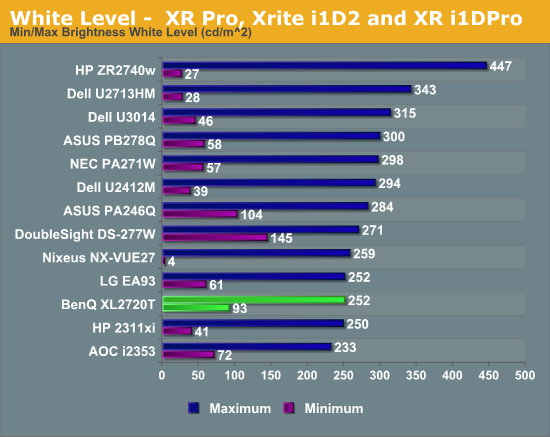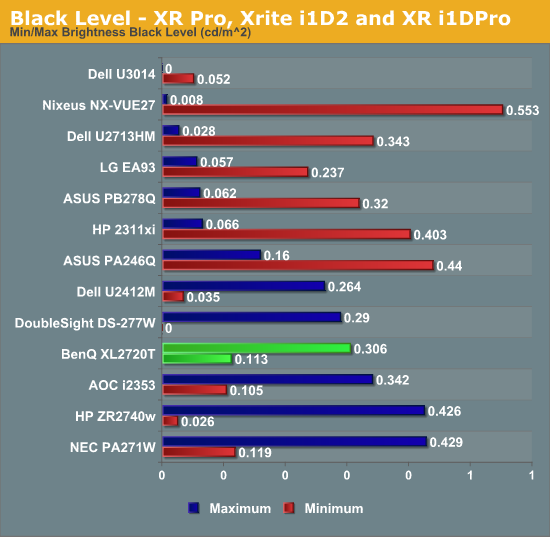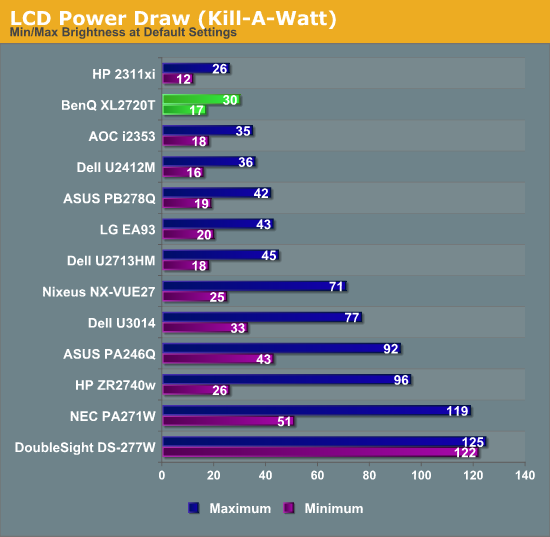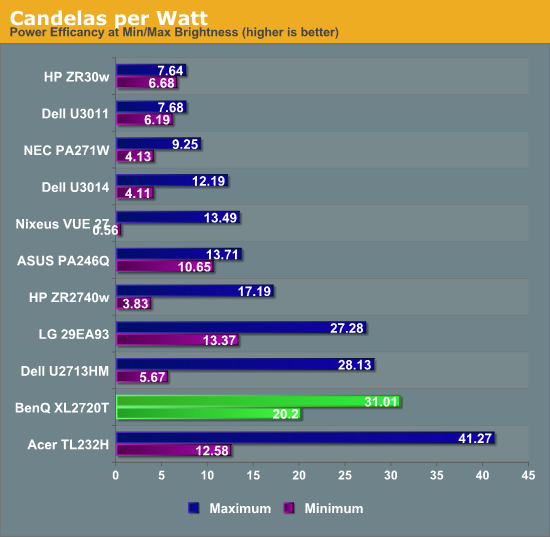BenQ XL2720T Gaming Monitor Reviewed
by Chris Heinonen on June 17, 2013 4:35 PM ESTBenQ says that the maximum light output of the XL2720T is 300 nits, but the most I could record is 252 nits while not totally crushing whites. It might be possible to set the contrast to 100 and record a higher number, but with that setting the top white shades, from around 230 until 255, all blend into a single shade. No one would ever use a display this way, so it’s a bit impractical for me to measure them this way. The lowest white level I could get was 93 nits, which helps to explain the contrast ratio issue on the sRGB test. If we are targeting 80 nits, and the lowest level the display can natively do is 93 nits, then the video card LUT has to be lowered to bring that brightness down. Anytime you lower the peak of the LUT, you then start losing contrast range, which is why we try to get the monitor set as close as possible before calibration, or use DDC to have it automatically do it correctly.

The black level was fine on the XL2720T, though not exceptional as TN isn’t known for being great at blocking out light. It isn’t a bad number, but black level is really all about contrast ratio and on its own doesn’t mean much unless we also know the white value.

The contrast ratio on the BenQ comes out at right around 820:1 at maximum or minimum light level. The lower number we saw on the sRGB calibration was due to targeting a light output level below what the monitor can do natively. If you aren’t trying to go below the 95 nits light level that I saw on the white testing, you will get a contrast ratio right around 820:1 from the XL2720T.

The BenQ XL2720T also does well on power usage, consuming very little at maximum or minimum backlight levels. Other than the Acer touchscreen model, the BenQ is the most efficient monitor for which I have calculated the Candelas per Watt number, which takes into account screen size, power use, and light output to normalize the data. I have a feeling the BenQ benefits by having a lower resolution 27” panel than most of the 27” monitors I’ve tested, but with the small number of data points I have so far that is all conjecture at the moment. Whatever the cause of it, the power use of the BenQ is very low.












79 Comments
View All Comments
Panzerknacker - Tuesday, June 18, 2013 - link
Yes they did, TN panels just produce such mediocre image quality that there is no immersion anymore of any kind. Lighting effects are just colored spots on a TN, black levels are non existant, if you move from CRT to TN you will just give up on gaming, trust me. Plasma is the best of the currently available displays, good respons and superior image quality, but they start at 40 inches which is too big and you cannot comfortable use them for still images such as desktop due to burn in problems.qiplayer - Saturday, November 9, 2013 - link
See my 5800x1080 fast gaming on youtube channel qiplayer. Im here looking for 120hz, I actually own 3 asus ve278, the image is great the only downside is blur image when moving fast. But whatch the vid, you'll see that you can actually game quite fast also on 60hz monitors.bji - Monday, June 17, 2013 - link
The retina display in my macbook pro looks better than any CRT I ever saw, hands down.Also I put an older Mitsubishi Diamondtron 21 inch next to a fairly old Dell 24 inch IPS panel and I didn't find that I favored one over the other.
BillyONeal - Monday, June 17, 2013 - link
The retina is an IPS panel, so I don't see what point you're trying to make here.A5 - Monday, June 17, 2013 - link
You must only be remembering the good CRTs. Bad CRTs were really, really bad.Not to mention heavy, power inefficient, giant bezels, expensive, etc. I sure as hell wouldn't be able to afford 2 1080p+ CRT monitors, and they probably wouldn't fit on my desk, either.
mdrejhon - Tuesday, June 18, 2013 - link
Panzerknacker, have you tested LightBoost? Google "LightBoost:They give you perfect CRT quality sharp motion on an LCD:
-- Fast panning as perfectly sharp as stationary images.
-- I can read text even during fast scrolling
zehoo - Tuesday, June 18, 2013 - link
Perhaps you should try one of the Korean IPS or PLS 2560x1440 panels that overclock to 120hz if you want better colour reproduction than a TN panel while still having low input latency (models with OSD bypass) and a decent refresh rate. I haven't been able to go back to a 1080 TN 120hz panel since using one.Of course 120hz TN lightboost hack panels is where it's at for the moment if you need low input latency and fast refresh rates for competitive gaming. The trade off being superior colours. By the way I moved from CRT to LCD and didn't stop gaming. Though I only moved when 120hz TN panels first became available.
EnzoFX - Monday, June 17, 2013 - link
Processing lag. I would think this would still be #1 priority for a gamer. I'm surprised it's so high.Guspaz - Monday, June 17, 2013 - link
The first page is called "INTRODUCTION, DESIGN AND SPECS", but there are no specs on the page. I don't even see any mention of the resolution. Is it 1920x1080, 1920x1200, 2560x1440, 2560x1600? There should be a table on this page listing all the details: manufacturer, model, size, resolution, panel type, price, inputs, etc.metril - Monday, June 17, 2013 - link
The first thing I looked for was the monitor resolution and other necessary information. I found nothing. How am I supposed to trust this review if none of the relevant information is presented?